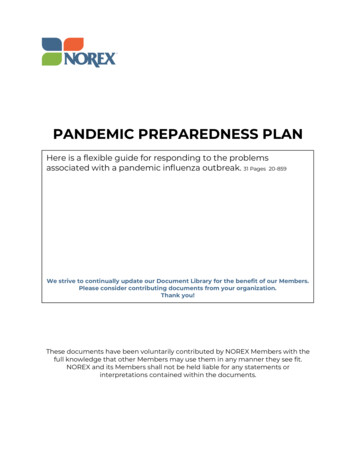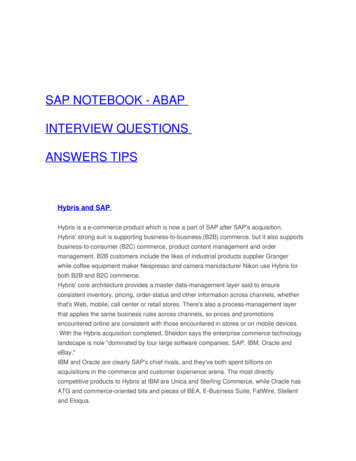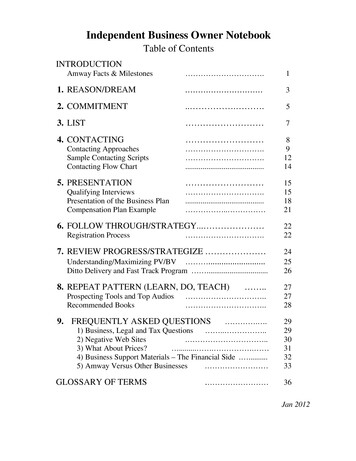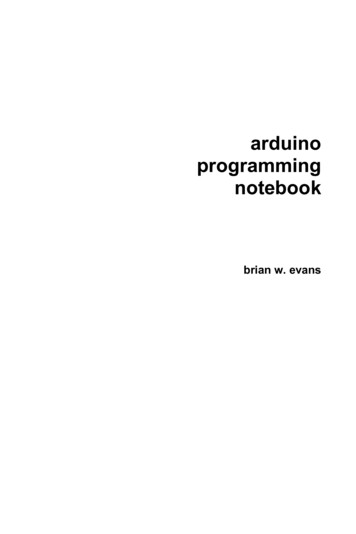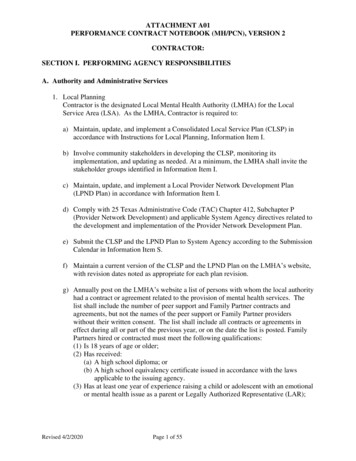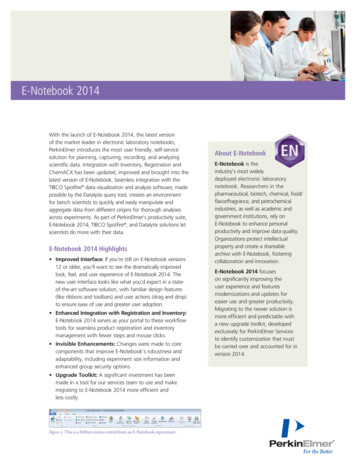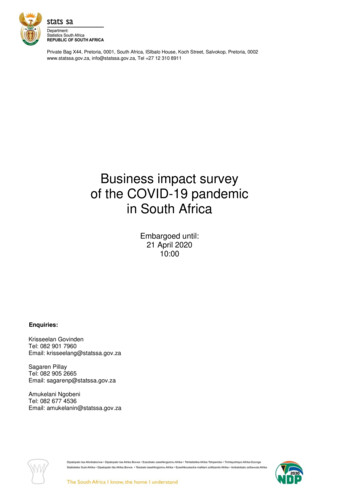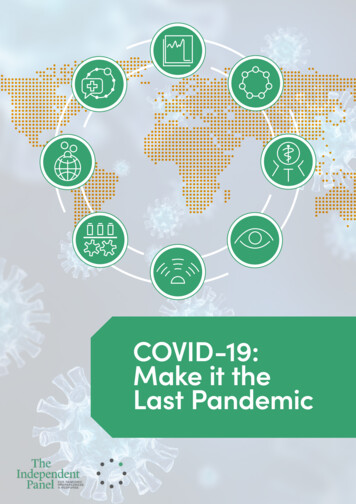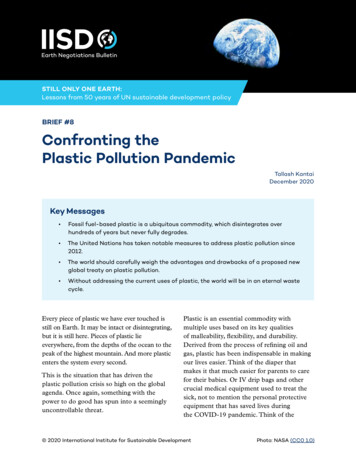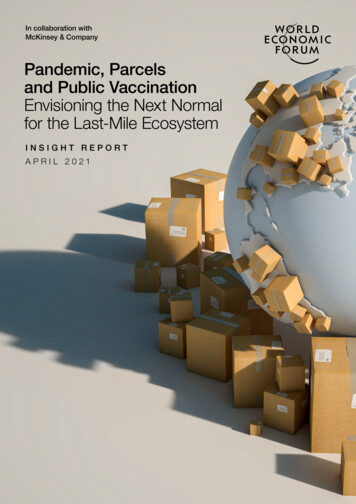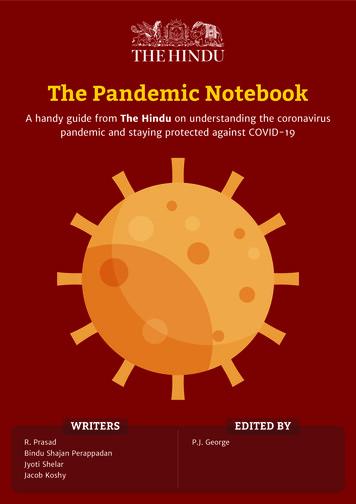
Transcription
The Pandemic NotebookA handy guide from The Hindu on understanding the coronaviruspandemic and staying protected against COVID-19WRITERSR. PrasadBindu Shajan PerappadanJyoti ShelarJacob KoshyEDITED BYP.J. George
Introduction1What are coronaviruses?2A closer look at SARS-CoV-23High transmissibility5Spike structure5Genome sequencing5Understanding the disease7How does the disease spread?7Who is affected?7What are the symptoms?9How can it be detected?9What is the treatment?9Can a vaccine be developed for COVID-19?Protecting yourself against COVID-191011Washing with soap11Alcohol-based hand sanitisers12Using a mask12Social distancing13Avoid touching eyes, nose and mouth13Practise respiratory hygiene13Some common queries answered14Are there differences between symptoms caused by the flu and COVID-19?14How effective are thermal scanners in detecting people infected with thenew coronavirus?14Can a person exposed to Coronavirus transmit it to others if he/she uses aswimming pool?14Should people avoid eating meat-based food to prevent transmission?15Is there a link between a person’s immunity and COVID-19 transmission?15Are there any home remedies to treat COVID-19?15Are antibiotics effective in preventing and treating the new coronavirus?15Do vaccines against pneumonia protect you against the new coronavirus?16Myths around COVID-1916Myth: “COVID-19 virus cannot be transmitted in areas with hot and humid climates”17Myth: The new coronavirus can be transmitted through mosquito bites.17National and State helplines18
IntroductionOn December 31, 2019, China informed the World Health Organization of acluster of cases of pneumonia of an unknown cause in Wuhan City in Hubeiprovince. On January 9, 2020, the WHO issued a statement saying Chineseresearchers have made “preliminary determination” of the virus as a novelcoronavirus.Since then, more than 6,000 deaths have been reported due to COVID-19 acrossthe world till March 20, 2020. Cases have been reported from more than 180countries, including India. Lockdowns, curfews, massive airport screenings,quarantines, and social distancing have become the norm across the globe.In these critical times, access to authentic information is of paramountimportance. The Hindu has been covering the pandemic since the early days withthe highest journalistic standards, ensuring that science and safety are the primaryfocus. For the benefit of our readers, we are now compiling the most relevantparts of our coverage in the form of an eBook, that we hope will be a handy guideto good health practices as well as in fighting misinformation.1
What are coronaviruses?Coronaviruses are a large family of viruses with some causing lesssevere common cold to more severe diseases such as severe acuterespiratory syndrome (SARS) and Middle East respiratory syndrome(MERS). The SARS-CoV-21 is a coronavirus very similar to the onethat caused SARS.Many coronaviruses are zoonotic, meaning they are transmitted fromanimals to humans.While the SARS coronavirus is thought to be an animal virus from anas-yet-uncertain animal reservoir, perhaps bats, that spread to otheranimals (civet cats) and first infected humans in the Guangdongprovince of southern China in 2002, the MERS coronavirus was passedon from dromedary camels to humans in Saudi Arabia in 2012.There is evidence that the SARS-CoV-2 has also been transmitted frombats1 TheCoronavirus Study Group of the International Committee on Taxonomy of Viruses, which had assessed thenovelty of the human pathogen, has named the virus as “Severe acute respiratory syndrome coronavirus 2”, or“SARS-CoV-2”. The Coronavirus Study Group is responsible for developing the official classification of virusesand taxa naming of the Coronaviridae family.2
A closer look at SARS-CoV-2The ultrastructural morphology exhibited by the SARS-CoV-2 seen in an illustration released by theCenters for Disease Control and Prevention on January 29, 2020. Image Credit: ReutersLike other coronaviruses, SARS-CoV-2 virus particles are sphericaland have mushroom-shaped proteins called spikes protruding fromtheir surface, giving the particles a crown-like appearance. The spikebinds and fuses to human cells, allowing the virus to gain entry.Researchers at the University of Texas at Austin and the NationalInstitutes of Health, U.S., have produced a 3D atomic scale map of theprotein of the SARS-CoV-2 that binds to and infects human cells.Mapping the 3D structure of the protein — spike (S) glycoprotein —will allow better understanding of how the virus binds to the humancells. Knowing the structure of the spike protein will, in turn, allowscientists to develop vaccines and antivirals against the virus and evenbetter diagnostics.3
The spike protein of the novelcoronovirusshares98%sequence identity with thespike protein of the batcoronavirus, the researcherssay. The results were publishedin the journal Science.Similar yet differentThe researchers also found thatlike in the case of the SARScoronavirus, the spike proteinof the SARS-CoV-2 that causesCoronavirusDisease192(COVID-19) binds to thecellularreceptorcalledangiotensin-converting enzyme2 (ACE2), which serves as theentry point into human cells.But unlike in the case of SARS,the spike protein of the novelcoronavirus binds to the cellreceptor with much higheraffinity — 10- to 20-foldhigher.2 Concernedabout the stigma that names of new diseases can cause to certain people and religion, the WHO cameup with the new guidelines in May 2015. According to the guidelines, name of a new disease should consist of acombination of terms. These terms consist of a generic descriptive term based on clinical symptoms (respiratory),physiological processes (diarrhoea), and anatomical or pathological references (cardic). It can refer to specificdescriptive terms such as those who are afflicted (infant, juvenile, and maternal), seasonality (summer, winter)and severity (mild, severe). The name can also include other factual elements such as the environment (ocean,river), causal pathogen (coronavirus) and the year the new disease is first detected with or without mentioningthe month.4
High transmissibilityThe much greater binding affinity to the cell receptor explains theapparent high human-to-human transmissibility of the virus comparedwith the SARS coronavirus.“The high affinity of the 2019-nCoV S for human ACE2 maycontribute to the apparent ease with which the 2019-nCoV can spreadfrom human-to-human,” the researchers write. “Additional studies areneeded to investigate this possibility.”Since both the SARS coronavirus and the 2019 novel coronavirus sharestructural similarity and bind to the same receptor, the researcherstested three monoclonal antibodies specific to SARS virus for theirability to bind to the novel coronavirus. But none of the three antibodiestested were found to be effective in inhibiting the novel coronavirusfrom binding to the human receptor ACE2 and prevent or treat thedisease.Spike structureHowever, the 3D map of the S protein will help researchers design newantivirals to stop the virus from binding and infecting human cells.“Knowing the atomic-level structure of the 2019-nCoV spike willallow for additional protein engineering efforts that could improveantigenicity and protein expression for vaccine development,” theresearchers write.The researchers were able to determine the structure of the spikeprotein as the Chinese researchers shared the whole genome sequencedata in the global database.Genome sequencingWhen the entire genome is sequenced it helps researchers understandthe arrangement of the four chemical entities or bases that make up theDNA or RNA. The differences in the arrangement of the bases make5
organisms different from one another. Sequencing the genome ofSARS-CoV-2 will help us understand where the virus came from andhow it spread. For instance, by sequencing the genome of the virusisolated from an Indian patient, it will become possible to know if thevirus had come from China or any other countryIn India, the Pune-based National Institute of Virology (NIV)3 hassequenced the SARS-CoV-2 genome collected from two patients inKerala.3 NIVis the only lab in India which has a bio-safety level-4 (BSL-4) facility to culture pathogenic, novel viruses,study the origin of such viruses and provide a comprehensive characterisation of them by sequencing the entireviral genome.6
Understanding the diseaseTheWorld Health Organisation has declared COVID-19 to be apandemic4. The symptoms of COVID-19 appear within two to 14 daysafter exposure and include fever, cough, a runny nose and difficulty inbreathing.How does the disease spread?It primarily spreads through the respiratory droplets of infected people.If a person touches a surface or object that has been infected by thevirus and then touches his own mouth, nose, or eyes, he may getinfected.Who is affected?While people of all ages can be affected by the disease, people aged 80and above are at the highest risk of dying due to COVID-19, accordingto case records analysed by the Disease Control and Prevention Centersin China and South Korea. Victims of the virus with pre-existingmedical conditions such as cardiovascular disease and diabetes have ahigher fatality rate than others. Also the rate of fatalities was relativelyhigher for retirees.4A ‘Pandemic’ generally refers to an epidemic that has spread on a more global scale, affecting large numbers ofpeople. Exactly when enough places have enough infections to declare one isn’t a black-and-white decision. Butgenerally, the WHO is looking for sustained outbreaks on different continents. An ‘Epidemic’ is a large outbreak,one that spreads among a population or region. An ‘Outbreak’ is a sudden rise in cases of a disease in a particularplace.7
Data visualisations by Vignesh Radhakrishnan and Sumant Sen8
What are the symptoms?The guidelines5 from the Union Health Ministry for early recognitionof COVID-19 patients are those who come in with Severe AcuteRespiratory Infection (SARI) who also have a history of foreign travelor close contact with another COVID-19 patient.As per the guidelines, “COVID–19 may present with mild, moderate,or severe illness; the latter includes severe pneumonia, ARDS [AcuteRespiratory Distress Syndrome], sepsis and septic shock.”How can it be detected?The virus can be detected using a RT-PCR test6. An RT-PCR or reversetranscription polymerase chain reaction test is DNA-based and canquickly tell if someone harbours the virus. In India, the governmentfacilities to test for the virus include 52 labs belonging to the ViralResearch and Diagnostic Laboratories network of the Indian Councilof Medical Research (ICMR), 10 labs under the National Centre forDisease Control (NCDC), and the NIV.What is the treatment?There is no current evidence from randomised controlled trial torecommend any specific treatment for suspected or confirmed COVID19 patients. No specific anti-virals are recommended for treatment ofthose suffering from respiratory ailment due to lack of adequateevidence from medical literature.5Guidelines on Clinical Management of COVID – 196The National Human Genome Research Institute on PCR:“Sometimes called "molecular photocopying," the polymerase chain reaction (PCR) is a fast and inexpensivetechnique used to "amplify" - copy - small segments of DNA. Because significant amounts of a sample of DNAare necessary for molecular and genetic analyses, studies of isolated pieces of DNA are nearly impossiblewithout PCR amplification.Often heralded as one of the most important scientific advances in molecular biology, PCR revolutionized thestudy of DNA to such an extent that its creator, Kary B. Mullis, was awarded the Nobel Prize for Chemistry in1993.”9
In India, the Union Health Ministry guidelines has recommended useof anti-HIV drug combinations Lopinavir and Ritonavir on a case-tocase basis depending upon the severity of the condition of a personhaving coronavirus infection.The Ministry recommended Lopinavir-Ritonavir for high-risk groups:patients aged above 60, suffering from diabetes mellitus, renal failure,chronic lung disease and are immuno-compromised.However, the use of Lopinavir-Ritonavir in PEP regimens for HIV isalso associated with significant adverse events which many times leadsto discontinuation of therapy.The guidelines advise the treating doctors to closely monitor patientswith severe acute respiratory infection for signs of clinicaldeterioration, such as rapidly progressive respiratory failure and sepsis,and apply supportive care interventions immediately.“Application of timely, effective, and safe supportive therapies is thecornerstone of therapy for patients that develop severe manifestationsof COVID-19,” it said.Can a vaccine be developed for COVID-19?According to Raman. R. Gangakhedkar, head of the Epidemiology andCommunicable Diseases-I (ECD-I), Division of ICMR, there are twoways of going for vaccine preparation — either you look at thesequences of the gene which then may lead to development ofantibodies, or you actually have the strain and then you try to developa vaccine which is always an easier option. He said Indian scientistshave managed to successfully isolate the COVID-19 virus and about 11isolates are available which is a prime requisite for doing any kind ofresearch related to viruses and developing the vaccine.Internationally, several institutes and pharmaceutical companies are invarious stages of developing the vaccine with some set to go on clinicaltrials soon7.7From a report in The Guardian dated March 19, 2020: “The Oxford [University] vaccine, known as ChAdOx1, isone of five frontrunner vaccines in development around the world. The US biotech Moderna gave its firstvaccine shot to a person in Seattle earlier this week. Another US firm, Inovio, will soon start trials on its own10
Protecting yourself against COVID-19Guidelines by the World Health Organization specify that one of thew
Myth: “COVID-19 virus cannot be transmitted in areas with hot and humid climates” 17 Myth: The new coronavirus can be transmitted through mosquito bites. 17 National and State helplines 18. 1 Introduction On December 31, 2019, China informed the World Health Organization of a cluster of cases of pneumonia of an unknown cause in Wuhan City in Hubei province. On January 9, 2020, the WHO .
